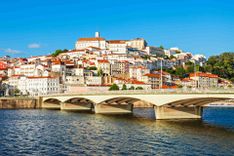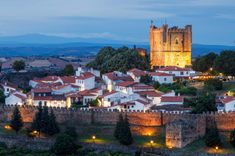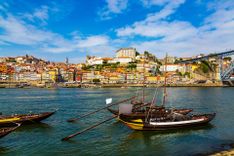Planning your own trip? Prepare for your trip
Use Rough Guides' trusted partners for great rates
Plan and book your private, tailor-made tour with vetted local experts
East of Peso da Régua, the N222 road follows the south bank of the Douro while the railway hugs the north, winding past terraced vineyards until both meet at Pinhão. Just 25km from Régua, this small town sits at the heart of the Douro region, surrounded by steep hills striped with vines.
There is a real sense of arrival here. The river broadens, cruise boats line up along the promenade, and a few cafés and bars overlook views that feel almost fjord-like. In the evenings, a breeze drifts in from the water, welcome after a hot day in the valley. From the town, a short but steep 7km drive leads to Casal de Loivos, a tiny village with a viewpoint that many consider the best in the Douro.

Hey, I’m Joel, your Portugal travel expert. If the Douro Valley is the country’s wine heartland, then Pinhão is where it beats the strongest. This riverside town is small, but everything around it is steeped in wine culture. The hills are etched with terraced vineyards, the boats on the river carry visitors instead of barrels these days, and the tiled train station celebrates the grape harvest in blue-and-white scenes.
The best part is how easy it is to slow down here. You can take a boat trip on the Douro, visit a wine estate for tastings, or just sit by the river with a glass of port and watch the sun slip behind the ridges. The scenery changes with the seasons: spring brings wildflowers among the vines, harvest season fills the valley with color and activity, and winter mornings can be crisp and misty in a way that feels timeless.
This Pinhão travel guide gives you the essentials: when to come, how to get here, where to stay, and what to do once you arrive. It is a place best enjoyed at a leisurely pace, where every bend in the river feels like a new postcard.
Joel’s tip
Take the train at least once. The ride from Peso da Régua to Pinhão is short, but the views of the terraced valley and the river curling below are some of the most beautiful in Portugal.
Best time to visit
Spring and autumn are the best seasons in Pinhão. Days are warm, skies are clear, and the vineyards are at their most scenic, with flowers in spring and harvest colors in autumn. July and August can be very hot, with afternoon highs often above 86°F (30°C). Winter is cooler and quieter, with misty mornings on the river and far fewer visitors.
How to get to Pinhão
The train from Peso da Régua to Pinhão runs along the north bank of the Douro and is one of the most scenic routes in Portugal, taking about 25 minutes. There are regular services from Porto to Régua, with connections onward to Pinhão. Driving from Porto takes around two hours, following the winding N222 or the faster A4 and A24 motorways. Arriving by boat is also possible, with Douro cruises stopping at Pinhão’s riverside quay.
Best areas to stay in Pinhão
Pinhão lies in northern Portugal, in the heart of the Douro Valley wine region, about 25km east of Peso da Régua and roughly two hours by car or train from Porto. It sits on a bend in the Douro River, surrounded by steep terraced hillsides covered in vines.
Often included among the best places to visit in Portugal for wine and scenery, Pinhão fits easily into a Portugal itinerary that explores the Douro Valley. From here, you can take several trips along the river, ride the scenic railway line, visit working quintas for tastings, or drive up to nearby viewpoints such as Casal de Loivos for some of the finest panoramas in the valley.
Make sure to check out this great Portugal trip Porto, where you'll visit Pinhao but also Lisbon, Porto and other great places!
















Pinhão is small and easy to navigate, with most of the action along the riverfront and around the train station. The surrounding quintas and viewpoints are further out, so you’ll need transport to reach them.

Douro Valley and Pinhao town, Portugal @ Shutterstock
If you are asking how many days in Pinhão are enough, a single full day lets you experience the essentials: a walk along the riverfront, a visit to the tiled train station, a boat trip on the Douro, and a tasting at one of the nearby quintas. But if you can, stay overnight. Once the cruise boats depart, the town slows down, the light softens over the vineyards, and the evenings feel unhurried.
If you are planning a 7-day itinerary in Portugal that includes the Douro Valley, consider giving Pinhão two or even three days. Spend one day exploring the town and local estates, another taking a river cruise or riding the scenic railway, and a third driving or hiking to viewpoints like Casal de Loivos or further into the valley. An extra night also means you can enjoy both sunrise and sunset over the terraces.
Pinhão has a small but charming selection of places to stay, from riverside hotels to vineyard estates on the surrounding hills. Here’s where to base yourself depending on how you like to travel.

Train station of Pinhao in the Douro Valley in Portugal © Shutterstock
Pinhão may be small, but it is surrounded by some of the most beautiful landscapes in Portugal. Its riverside location, tiled station, and nearby quintas make this place ideal for relaxation. Here is a list of things to do in Pinhão, each of which deserves to be paused and enjoyed.
The station is small, but its walls are covered with 24 panels of blue-and-white tiles from the 1930s that depict the grape harvest, barrel rolling, and river boats stacked with casks of port. They tell the story of the Douro in pictures and are one of the most photographed spots in town.
Step inside the waiting room to see more panels and details often missed by people rushing for the train. Early morning is the quietest time to visit, before day-trippers arrive, and the tiles glow in the soft light.
Pinhão’s quay is lined with rabelos, the traditional wooden boats once used to carry wine barrels downriver to Porto. Today they take visitors upstream or downstream on trips that last from an hour to a full day.
Short cruises give you a taste of the valley’s terraced vineyards and steep hills, while longer ones drift past remote villages and dramatic bends in the river. The pace is slow, the water calm, and the views unforgettable. Bring a hat and sunscreen in summer, as the decks are exposed.
The quintas, or wine estates, around Pinhão are the backbone of the valley. Many open their doors for guided tours, tastings, and even overnight stays. Walking among the terraced vines, you’ll learn how grapes are harvested, pressed, and aged into port and Douro wines.
Quinta do Bomfim and Quinta das Carvalhas are two of the best-known, with tours that end in shaded tasting rooms overlooking the river. Smaller family-run estates offer a more intimate experience, often with homemade snacks alongside the wine. Harvest time in September is the busiest and most atmospheric, when you may see workers crushing grapes by foot in granite lagares.
A 10-minute drive up winding roads leads to Casal de Loivos, a small village with one of the Douro’s most celebrated viewpoints. From here, the river snakes through steep terraces, with Pinhão far below and ridges fading into the horizon.
The miradouro is signposted, with a few benches to sit and take in the view. Early evening is magical, when the sun sets behind the hills and the terraces glow gold. It is worth the effort even if you only have a short time in town.
Pinhão’s waterfront is the town’s living room. Locals gather here in the evenings to chat, fishermen mend their nets, and boats tie up after cruises. A few cafés and bars spill onto the promenade, the perfect place for a glass of wine at sunset.
The atmosphere is unhurried, and the broad walkway makes it easy to linger. On hot afternoons, the breeze off the river offers a welcome break from the valley heat.
Beyond Pinhão, the Douro line continues east toward Tua, Pocinho, and the Spanish border. The track hugs the river in places, giving you views you cannot see by road. The journey is slow but beautiful, passing tiny stations, olive groves, and steep vineyards that seem to tumble into the water.
Even a short hop eastward makes a memorable outing. Sit on the right-hand side for the best views, and bring snacks, services are infrequent and stations remote.
Pinhão’s restaurants focus on hearty northern dishes. Look for roast kid goat, grilled river fish, and soups made with local vegetables. Many quintas serve lunches paired with their wines, while riverside tascas offer simpler meals of codfish and stews.
Desserts often feature local honey and almonds, while port is the natural choice to end any meal. Try a tawny with a slice of sponge cake or a glass of white port as an aperitif on a hot afternoon.

Train station of Pinhao in the Douro Valley in Portugal © Shutterstock
Several marked trails begin near Pinhão, leading into the terraced hillsides and through olive groves. Routes range from short loops that take an hour to full-day hikes linking neighboring villages. It is one of the best areas to experience traditional vineyard landscapes on foot, and a reminder of why the Douro is often included among the most rewarding hikes in Portugal.
Along the way, you will pass stone walls, tiny chapels, and old vineyard cottages. Summer afternoons can be punishingly hot, so start early or come in spring and autumn, when the light is clear and the vines are at their most colorful.
A short train ride or drive west, the Douro Museum in Peso da Régua gives context to what you see in the valley. Exhibits explain the history of the port, the role of the rabelos, and the transformation of the landscape through centuries of terracing.
It makes a worthwhile half-day trip, especially if you want to understand the valley beyond its views. Combine it with lunch in Régua before returning to Pinhão by train or car.
One of the most memorable experiences in Pinhão is sleeping in a working wine estate. Many quintas have converted manor houses into guest rooms or built small boutique hotels among the vines. You wake up to mist lifting from the river, spend the day exploring, and return to watch the sunset with a glass of wine in hand.
Staying overnight also lets you enjoy the valley after the day-trippers have gone, when silence falls over the terraces and the stars shine bright above.
Pinhão has a Mediterranean climate with strong continental influence, meaning very hot summers, mild winters, and marked temperature swings between day and night. Its riverside setting makes summer evenings cooler than afternoons, but July and August can be scorching. Average temperatures range from about 43°F (6°C) in January to 91°F (33°C) in August, though heatwaves can push it well above 100°F (38°C). Misty mornings are common in autumn and winter, giving the valley a quiet, atmospheric feel. For current forecasts, check IPMA (Portuguese Institute for Sea and Atmosphere).

Making Portuguese the codfish cake © Shutterstock
Pinhão’s dining scene reflects its riverside setting and wine culture. Many restaurants are small, family-run, and focus on northern Portuguese flavors: hearty meats, freshwater fish, and plenty of dishes designed to pair with Douro wines. Expect generous portions, simple preparation, and terraces overlooking the river or vineyards.
Here are some unique experiences to make the most of your time in the Douro Valley. All are private, flexible, and led by local experts.
Discover Portugal's most captivating stories
Use Rough Guides' trusted partners for great rates
written by
Olga Sitnitsa
Online editor at Rough Guides, specialising in travel content. Passionate about creating compelling stories and inspiring others to explore the world.